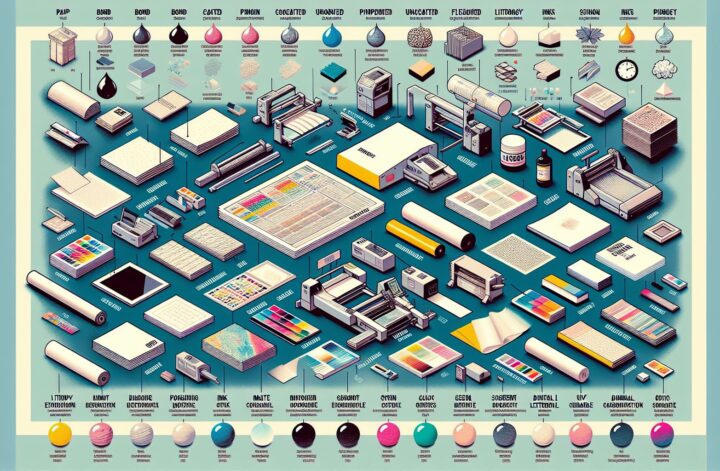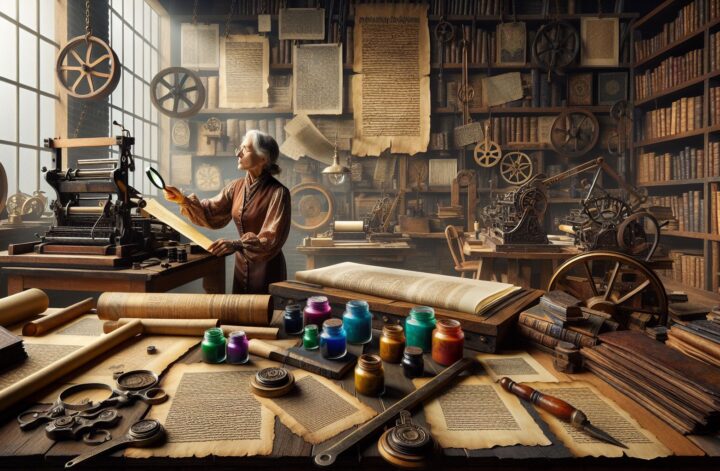As technology continues to advance, the world of printing has transformed drastically. Gone are the days when printing was limited to simple text and basic images on paper. Today, printing materials have expanded to include a wide range of options, allowing for endless possibilities and creative expression. From different types of paper and textiles to innovative 3D printing materials, the printing industry has opened up a whole new world for designers and creators. In this article, we will explore the exciting realm of printing materials, their various applications, and the future of this dynamic industry.
Introduction: The Evolution of Printing Materials
Printing has been a cornerstone of human communication for centuries. From the earliest forms of paper printing in ancient China to the revolutionary Gutenberg printing press, the technology has continuously advanced. With the advent of digital printing, the possibilities for printing materials have expanded exponentially.
Traditionally, paper has been the go-to material for print media, including books, newspapers, and signage. However, as technology has progressed, designers and creators have pushed the boundaries of what can be printed upon. Printing materials now include textiles, plastics, metals, ceramics, and even edible substances. This diversification has given rise to innovative products and practical applications across various industries.
The Diverse World of Printing Materials
1. Paper and Cardstock
Paper remains central to the printing industry, offering a versatile and cost-effective medium for many applications. From standard office paper to specialty textures and finishes, paper offers endless possibilities for printing everything from business cards and brochures to packaging and labels. Cardstock, a thicker and sturdier type of paper, is commonly used for invitations, postcards, or high-quality brochure covers. Different paper thicknesses, coatings, and colors provide diverse options for any printed project.
2. Textiles and Fabrics
Printing on fabrics has unleashed a whole new world of possibilities. From personalized t-shirts and custom home textiles to high-quality fashion garments and interior designs, printing on textiles allows for vibrant color, intricate patterns, and unique branding opportunities. With advancements in digital textile printing, it is now possible to print directly onto fabric, providing greater design freedom compared to traditional methods like screen printing.
3. Plastics and Films
The printing industry has also embraced plastics and films as versatile printing materials. With a range of options, including vinyl, PVC, PET, and more, printing on plastics offers durability, weather resistance, and flexibility. Plastics are commonly used for banners, signage, vehicle wraps, and packaging. The ability to print on films allows for stunning window displays, privacy films, and even holographic effects.
4. Metals and Ceramics
Printing on metals and ceramics has revolutionized the world of manufacturing and product customization. Using techniques such as direct metal laser sintering, it is now possible to 3D print objects in materials like titanium, steel, or even gold. This advancement opens up possibilities for complex and customized manufacturing, including applications in aerospace, automotive, and medical industries. Ceramic printing techniques enable the creation of intricate and delicate objects like artistic pottery, porcelain dishware, and even dental crowns.
5. Food and Edible Substances
Printing on food and edible substances is one of the most exciting and groundbreaking applications of printing materials. With the advent of food-grade ink and specialized printers, it is now possible to create artistic designs on cakes, cookies, chocolates, and more. This technology has also been used to improve food safety, such as labeling allergens or expiration dates directly on products. Additionally, printing materials like edible paper or sugar sheets can be used to create unique decorations for pastries and desserts.
Applications and Innovations
The diverse range of printing materials opens up a multitude of applications and innovations. Here are just a few examples:
1. Advertising and Marketing
In the competitive world of advertising and marketing, printing materials play a crucial role. With the ability to print on various mediums, companies can create eye-catching banners, posters, and billboards that engage and captivate their target audience. Innovative print applications like 3D billboards or interactive signage enhance brand messaging and create memorable experiences.
2. Interior Design and Décor
Printing materials have transformed interior design, allowing for personalized and visually stunning spaces. Textile printing enables custom wallpaper, upholstery, and curtains, while vinyl and film printing offer options for wall decals, window films, and floor graphics. The ability to print on various materials makes it possible to create unique and visually striking environments, from residential spaces to commercial establishments.
3. Fashion and Apparel
Printing on textiles has revolutionized the fashion and apparel industry, enabling customized designs, limited editions, and small production runs. With digital textile printing, designers can create intricate patterns, bold colors, and precise detailing on a variety of fabrics. This opens up opportunities for emerging designers, fashion startups, and independent artists to bring their visions to life.
4. Healthcare and Bioprinting
In recent years, printing materials have made significant advancements in healthcare. Bioprinting, a groundbreaking technique, allows for the creation of living tissues and organs using specialized printers and bio-ink. This technology holds the potential to revolutionize organ transplants and drug development, offering hope for a future where printing materials can save lives.
5. Manufacturing and Industrial Applications
Printing materials have revolutionized the manufacturing and industrial sectors. 3D printing, also known as additive manufacturing, enables the creation of complex and customized components with reduced waste and increased efficiency. This technology allows for rapid prototyping, tooling, and even the production of end-use parts across various industries, including automotive, aerospace, and electronics.
The Future of Printing Materials
As technology continues to advance at an unprecedented pace, the future of printing materials is filled with exciting possibilities. Here are a few trends and developments to watch for:
- Sustainable Printing: With increased focus on environmental sustainability, the printing industry is exploring eco-friendly materials, inks, and production methods to minimize waste and reduce carbon footprint.
- Smart and Functional Printing: The integration of printing with electronics and smart technologies enables the creation of functional objects like flexible displays, sensors, and wearable devices.
- Nanotechnology and Advanced Materials: Advancements in nanotechnology are allowing for the development of new printing materials with enhanced properties, such as increased strength, conductivity, or even self-healing capabilities.
- Biofabrication and Tissue Engineering: Bioprinting and the printing of living tissues hold immense potential for regenerative medicine, organ transplantation, and personalized healthcare solutions.
- Artificial Intelligence (AI) and Automation: AI-powered printing technologies streamline design processes, optimize print quality, and enable automation in material selection, proving to be a game-changer for the industry.
Conclusion
The world of printing materials is experiencing a renaissance, expanding beyond traditional paper to encompass a diverse range of possibilities. From textiles and plastics to metals and even edible substances, printing materials have unlocked new realms of creativity and innovation. The ability to print on various mediums has transformed industries, from fashion and advertising to healthcare and manufacturing. With the rapid advancement of technology, the future of printing materials holds even more exciting developments that will shape our world in ways we can only imagine. Prepare to be amazed by what the printed word can become!


